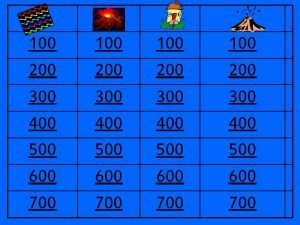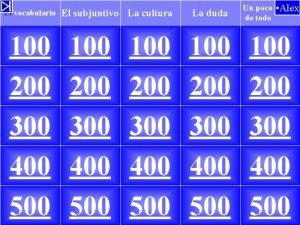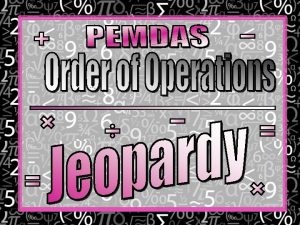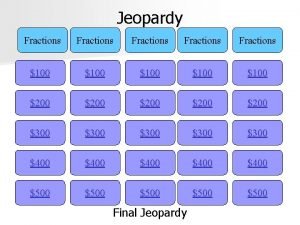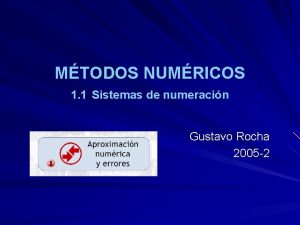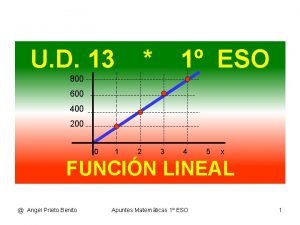100 200 200 100 200 300 300 400










































































- Slides: 74








$100 $200 $200 $100 $200 $300 $300 $400 $400 $500 $500

The graph of the equation is shown below.

What is y = (x + 2 1) ?

The equation of the parabola with this vertex is f(x) = (x + 8)2 - 4


The function for this graph is f(x) = (x – 2 5) – 1.

What is

This quadratic equation has a maximum point at (3, -4).

What is f(x) = (x – 2 3) – 4?

The cost in millions of dollars for a company to manufacture x thousand automobiles is given by the function C(x) = 3 x 2 – 18 x + 63. Find the number of automobiles that must be produced to minimize the cost.

3 thousand automobiles

Determine if the following is a polynomial function. If so, give the degree. f(x) = x 2 – 3 x 7




Use the leading coefficient test to determine the end behavior f(x) = 6 x 3 + 3 x 2 – 3 x - 1

Up to the right, Down to the left.

Find the zeros and their multiplicities of the function. F(x) = 4(x + 5)(x – 1)2

-1, multiplicity 1 1, multiplicity 2

Graph the function. F(x) = x 2(x – 3)(x – 2)


Use synthetic division to divide. 3 x 2 + 29 x + 56 x+7

3 x + 8

Divide using synthetic division.

4 x + 3 2 x R. 45 + 2 5 x + 10 x + 20.

Find f(-3) given f(x) = 4 x 3 – 6 x 2 – 5 x + 6


Solve the equation 3 x 3 – 28 x 2 + 51 x – 14 = 0 given that 2 is one solution.

2, 7, 1/3

Use synthetic division to find all zeros of f(x) = 3 x – 2 3 x – 18 x + 40.


Use the rational zeros theorem to list all possible rational zeros of f(x) = x 5 – 3 x 2 + 6 x + 14


Use the rational zeros theorem to list all possible rational zeros of f(x) = 3 3 x – 2 17 x + 18 x + 8 and then use this root to find all zeros of the function.

-1/3, 2, 4

Use Descartes’ Rule of Signs to determine the possible number of positive real zeros and negative real 6 zeros for f(x) = x – 8.

1 positive real zero 1 negative real zero

Give all the roots of f(x) = 3 x + 2 5 x + 12 x – 18


Use the graphing calculator to determine the zeros of f(x) = 3 x – 2 6 x –x+6 1, 3, 4, or 5

1, -1, 6

Use the Upper Bound Theorem to determine which of the following is a good upper bound for f(x) = 4 x + 3 x – 1, 3, 4, or 5 2 7 x – 5 x + 10


Find all roots of the equation. Hint: -2 i is one root. 4 x – 2 21 x – 100 = 0


Write the polynomial function as a product of linear factors. f(x) = 4 x – 2 3 x – 4


Factor completely. f(x) = 3 x + 2 4 x –x-4



Give an equation for the polynomial function that has zeros of 2, -2, and 3 and has a degree of 3.

f(x)= (x – 2)(x + 2)(x – 3) Other answers are possible.

Solve the inequality and give your solution in interval notation. (x – 3)(x + 2) > 0


Solve the inequality and give your solution in interval notation. x 2 + 3 x – 18 > 0


Solve the inequality and give your solution in interval notation. x 2 – 2 x – 24 < 0


Solve the inequality and give your solution in interval notation. x 2 – 3 x – 10 < 0


Solve the inequality and give your solution in interval notation. x 2 + 6 x < – 8





-10 < x < 10 -10 < y < 60

 200+400+600+800
200+400+600+800 100 200 300
100 200 300 100 200 300 400 500
100 200 300 400 500 100 200 300 400
100 200 300 400 100 200 300 400
100 200 300 400 100 200 300 400 500
100 200 300 400 500 100+200+300+400
100+200+300+400 100 100 100 100 100
100 100 100 100 100 300+200+200
300+200+200 100 200 300
100 200 300 200 + 200 + 300
200 + 200 + 300 200 + 200 + 300
200 + 200 + 300 300+300+400
300+300+400 300+300+400
300+300+400 300+300+400
300+300+400 400 + 300 + 300
400 + 300 + 300 300 + 300 + 400
300 + 300 + 400 300 300 400
300 300 400 300 square root
300 square root 200+200+100+100
200+200+100+100 200 300 400
200 300 400 400, 200, 100, 50, 25,
400, 200, 100, 50, 25, 200 300 300
200 300 300 100 200 300
100 200 300 Testojack 200 vs 300
Testojack 200 vs 300 100+100=200
100+100=200 300-400 lexile books
300-400 lexile books 200/400 meter training program
200/400 meter training program 150 sayısının 30 fazlası kaçtır
150 sayısının 30 fazlası kaçtır All factors of 88
All factors of 88 Irla reading levels
Irla reading levels What's 200 * 300
What's 200 * 300 Prime numbers 101-200
Prime numbers 101-200 Sometimes between 200-300 b.c
Sometimes between 200-300 b.c 300 150 100 ekg
300 150 100 ekg Wandering atrial pacemaker ecg
Wandering atrial pacemaker ecg If the interval size is decreased from $200 to $100
If the interval size is decreased from $200 to $100 Qdx=200-2px qsx=-100+4px
Qdx=200-2px qsx=-100+4px Equivalent fraction jeopardy
Equivalent fraction jeopardy Qdx=200-2px qsx=-100+4px
Qdx=200-2px qsx=-100+4px Gcf of 56
Gcf of 56 Héroïne dans la guerre de 100 ans (100 years war).
Héroïne dans la guerre de 100 ans (100 years war). What's 100 + 100
What's 100 + 100 Números romanos del 1000
Números romanos del 1000 100 iops/gb and 100,000 iops per volume oci
100 iops/gb and 100,000 iops per volume oci Box plot gcse
Box plot gcse Malloc lab 100/100
Malloc lab 100/100 C/100=f-32/180=k-273/100
C/100=f-32/180=k-273/100 A 400 newton girl standing on a dock
A 400 newton girl standing on a dock 400 gradi martina franca
400 gradi martina franca Imagine this if you had $86 400
Imagine this if you had $86 400 Unit daya
Unit daya 7% z 400
7% z 400 Layout cnab 400
Layout cnab 400 Calculating speed
Calculating speed Siklonyum bromür
Siklonyum bromür Bc atomic mass
Bc atomic mass 400
400 649
649 Punktesystem abitur
Punktesystem abitur Factoring polynomials jeopardy
Factoring polynomials jeopardy 800+600+400
800+600+400 400 kg
400 kg Retinotopia
Retinotopia 400 bc world map
400 bc world map 400 years of silence timeline
400 years of silence timeline Differenza tra monomi e polinomi
Differenza tra monomi e polinomi Nia 400
Nia 400 Corridas rasas
Corridas rasas Dewey 400
Dewey 400 Jvat 400
Jvat 400 The necklace theme
The necklace theme What are the positive and negative square roots of 6,400?
What are the positive and negative square roots of 6,400? 11-2 probability and punnett squares
11-2 probability and punnett squares Gefma 400
Gefma 400


